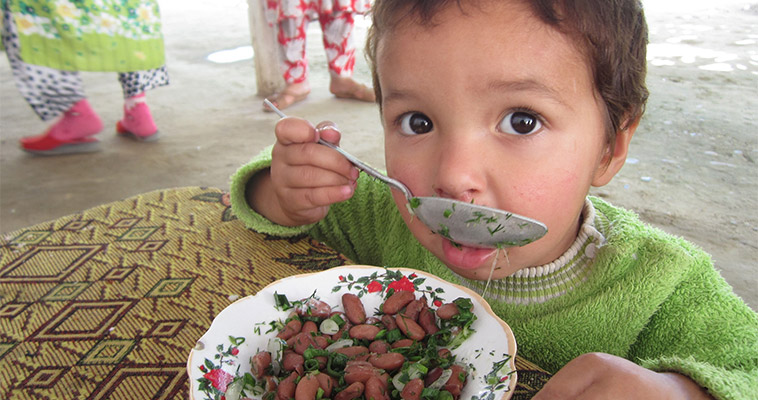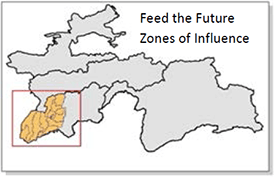
-
Tajikistan

-
Population
7.6 Million
-
Pop. Under 5
0.88 Million
-
% Stunting
26% Of Children Under 5
-
% Underweight
12% Of Children Under 5
Photo credit: USAID
At a Glance
- Background
- Nutrition Situation
- USAID Programs: Accelerating Progress in Nutrition
- Other USAID Nutrition-Related Development Assistance
Download the nutrition profile [PDF, 197KB]
Background
Tajikistan is a post-conflict country with significant food security needs. It is the poorest of the five Central Asian republics, with almost half the population living below the poverty line. Development of the agricultural sector, which accounts for 75 percent of employment and for 26 percent of GDP1, will be key to sustained growth; however, the sector remains challenged by the lack of arable land (only seven percent of total land), predominantly mountainous terrain, harsh winters, and frequent droughts.2 The population is growing rapidly, with 40 percent under the age of 17, creating a need for improved public services and employment opportunities for future generations. Tajikistan is estimated to reach MDGs 1 (eradicate extreme poverty) by 2018, but is not on track to reach MDGs 4 (reduce child mortality) and 5 (improve maternal health).3
Nutrition Situation
Three quarters of the population live in rural areas and spend 60-80 percent of their income on food.4 One-third of the population is affected by food insecurity, and more than 30 percent of those households are severely food insecure.5 The stunting rate in children under five has slightly decreased in the past four years, but acute malnutrition and underweight have increased.
Undernutrition is the underlying cause of 35 percent of child deaths in the country. The exclusive breastfeeding rate has increased but is still low, with only one-third of infants being exclusively breastfed. Undernutrition persists due to food insecurity, as well as lack of parental knowledge about managing common childhood illnesses, infant and young child feeding practices, inadequate dietary diversity, widespread diarrhea and poor health care seeking practices.
Tajikistan also has one of the lowest rates of access to clean water—with 42 percent of households lacking access—which along with poor hygiene and sanitation, increases diarrheal disease incidence and further exacerbates undernutrition, especially in children.6 Regional disparities in stunting exist, with the prevalence ranging from 19 percent in Dushanbe to 27 percent in Sughd and Khatlon Provinces. Rural children and children born to mothers with less education are more likely to be stunted.7
| Tajikistan Nutrition Data | ||
|---|---|---|
| Population | 7.6 million | |
| Population under 5 years of age (0-59 months) | 883,000 | |
| MNSS 20099 | DHS 20128 | |
| Prevalence of stunting among children under 5 (0-59 months) | 29% | 26% |
| Prevalence of underweight among children under 5 (0-59 months) | 8% | 12% |
| Prevalence of wasting among children under 5 (0-59 months) | 5% | 10% |
| Prevalence of anemia among children aged 6-59 months | 29% | n/a |
| Prevalence of anemia among women of reproductive age (15-49 years) | 24% | n/a |
| Prevalence of thinness among women of reproductive age (15-49 years) | 7% | 11% |
| Prevalence of children aged 0-5 months exclusively breastfed | 23% | 34% |
| Prevalence of breastfed children aged 6-23 months receiving a minimum acceptable diet | n/a | 17% |
National Nutrition Policies
The government is working closely with development partners to improve food security and nutrition. A National Health Strategy includes nutrition-sensitive policies and plans, and a Food Security Council (FSCT) was established in 2013 to coordinate decision making concerning food security. The Nutrition and Food Safety Strategy 2013–2020 was also finalized in the same year, but has not yet been approved by the government. It focuses on two key issues: the double burden of malnutrition (stunting, acute malnutrition, micronutrient deficiencies, and overweight) and prevention of food-borne diseases and nutrition-related non-communicable diseases.10 In 2013, Tajikistan joined Scaling Up Nutrition (SUN), a global movement that unites national leaders, civil society, bilateral and multilateral organizations, donors, businesses, and researchers in a collective effort to improve nutrition. USAID and UNICEF are donor co-conveners for the SUN initiative in Tajikistan.
USAID Programs: Accelerating Progress in Nutrition
| Highlighted Bilateral Nutrition Projects in Ethiopia | ||||
|---|---|---|---|---|
| Project Name | Year Awarded | End Date | Objective(s) | |
| Maternal and Child Health Project | 2008 | 2015 | Improves the health and nutrition status of women and children under five and engages local communities, especially pregnant women, mothers of children under five, and their mother-in-laws and husbands in health and nutrition discussions and links them with maternal and child services; trains the Health Department to improve delivery of quality maternal and child health services; helps plan and evaluate activities; and teaches schoolchildren health, hygiene and nutrition skills. | |
| UNICEF Micronutrient Supplementation Grant Field support |
2013 | 2015 | With USAID support, UNICEF assists the Ministry of Health in planning for, procuring, distributing, and monitoring micronutrient commodities and supplemental products. The project also assists the Ministry in the finalization and dissemination of the “Infant and Young Children Feeding Counseling Package,” which will serve as the national guidelines for the healthy feeding of children under two years. | |
| Improvement of Universal Salt Iodization in Tajikistan, Global Alliance for Improved Nutrition (GAIN) Field Support | 2012 | 2014 | The project assesses the salt iodization situation in Tajikistan in general and Khatlon in particular. It develops an action plan to address supply, demand, advocacy and M&E in order to achieve universal salt iodization in Khatlon, and provides technical assistance to the Government of Tajikistan in support of salt iodization. | |
Feed the Future Progress
Feed the Future, the U.S. Government’s global hunger and food security initiative, aligns with the country’s investment priorities and works with the World Bank-managed Global Agriculture and Food Security Program (GAFSP). The Feed the Future strategy focuses on the critical issue of food security by helping farmers improve production, income, and nutrition on household and small private farms; building local capacity to develop agricultural and health extension systems; and providing policy support to implement agrarian reform in selected districts. The Feed the Future initiative incorporates gender issues, working with women to improve agricultural productivity and health knowledge to ensure better nutrition and health for the family, especially children.
The Feed the Future initiative is implemented in 12 districts of Khatlon Province in the southwest region, along the border of Afghanistan. Khatlon is a major agriculture-producing region with the highest undernutrition rates and the largest number of people living below the poverty line. Khatlon’s irrigated watersheds and cotton-dominated agricultural production are promising places to demonstrate the effect of water and land reforms and crop diversification.
USAID/Tajikistan Feed the Future Goals
- Reduce the prevalence of poverty in Feed the Future target regions by 20 percent
- Reduce the prevalence of stunting in children under age five in Feed the Future target regions by 20 percent.
The Maternal and Child Health Project (MCH) is an extension of an earlier Mercy Corps project that was outside of the Feed the Future Zone of Influence; however, it moved into Khatlon as of July 2013. This project provides nutrition and health leadership and technical expertise, and complements other food security, agricultural production, and income generation activities in the region. Project objectives include improving infant and young child feeding, caring, and health care seeking practices; increasing the coverage and quality of maternal and newborn care; and increasing the capacity of facilities to deliver quality health services (especially counseling and nutritional support for mothers). In addition to activities that strengthen facility and community care capacities, this project also includes community-based behavior change communication on the Essential Nutrition and Hygiene actions (ENA/EHA).
In FY2012, Feed the Future worked with lead farmers to host 457 household demonstration plots to showcase improved crop varieties for income and home consumption. It also established 115 women’s savings groups, involving over 2,300 women, to increase access to productive economic assets, and provided training in food preservation and improved health and nutrition. In FY 2013, Feed the Future trained over 1,700 women in complementary feeding, improved diets for pregnant women, and the importance of exclusive breast feeding. In FY 2014, Feed the Future will train approximately 220,000 people in child health and nutrition practices. Starting in FY 2014, Feed the Future will amplify nutrition-sensitive agriculture and sanitation interventions , to assist beneficiaries in improving the composition of their diets and their access and use of water, sanitation and hygiene facilities, while complementing ongoing nutrition and MCH efforts to reduce stunting.

Active Global Nutrition Mechanisms
A micronutrient project funded through UNICEF is distributing prenatal micronutrients to pregnant women and micronutrient powder (Sprinkles) to children under two in the 12 Feed the Future districts. This project is implemented by UNICEF, WHO, the Ministry of Health, and the Aga Khan Foundation, as part of an existing complementary feeding program. Additionally, through GAIN, USAID is supporting the Government of Tajikistan to improve the quality and availability of iodized salt, as well as increasing consumer demand for the product.
Other USAID Nutrition-Related Development Assistance
The PEPFAR-funded SUPPORT project assessed HIV-related care and treatment services in Tajikistan and three other countries in Central Asia. The project will work with AIDS centers to integrate nutrition assessment, counseling, and support (NACS) into preventive and palliative care for people living with HIV.
Tajikistan joined the Committing to Child Survival: A Promise Renewed campaign, and pledged to reduce under-five mortality to 20 or fewer deaths per 1,000 live births by 2035 by reducing the leading preventable causes of child mortality, including undernutrition.
References
- Feed the Future Tajikistan Country Profile.
- CIA World Factbook.
- Millennium Development Goals Tracker, Tajikistan.
- World Food Program Tajikistan Country Overview.
- Tajikistan Emergency Food Security Assessment 2011.
- Tajikistan SUN website.
- Tajikistan Mission Full Performance Plan Report, 2012. USAID.
- Tajikistan Demographic and Health Survey, 2012. Statistical Agency & MOH, Dushanbe and MEASURE DHS, ICF International, Calverton, MD, USA, November 2013.
- Tajikistan Micronutrient Status Survey, 2009. MOH Tajikistan & UNICEF.
- Nutrition and Food Safety Strategy Tajikistan 2013-2020, WHO.







Comment
Make a general inquiry or suggest an improvement.